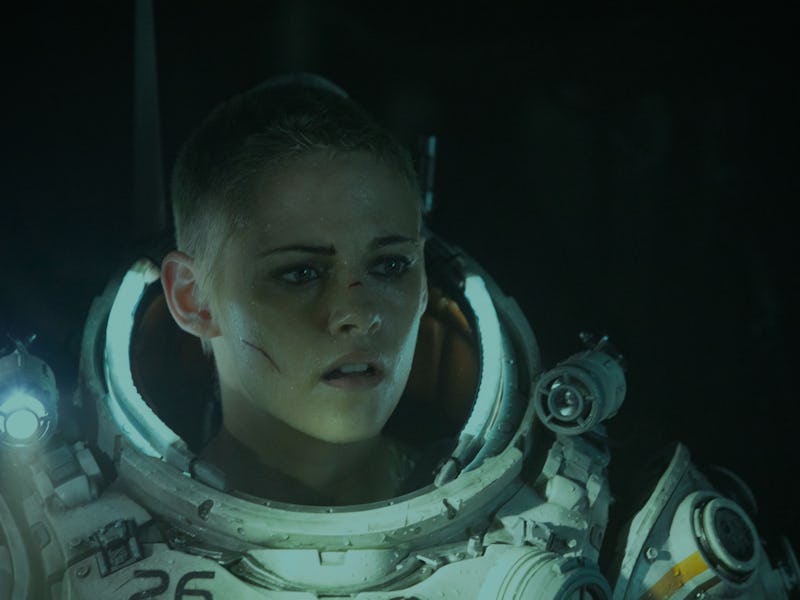A Kristen Stewart Sci-Fi Flop Did The Impossible: It Smuggled Cthulhu Into Theaters
Five years ago, Underwater did what many Lovecraft adaptations couldn’t.

William Eubank’s Underwater was a masterful display of intensity across the board. A creature feature that moves at breakneck pace, it starred Kristen Stewart as mechanical engineer Norah Price, who is part of the crew of a drilling facility at the bottom of the ocean in the near future. A crisis forces the remaining crew to undergo a dangerous trek across the Mariana Trench, where they discover that they’re not alone.
When it was released in January 2020, Underwater was praised in horror circles for its mile-a-minute first act and the deeply claustrophobic cinematography, though it was dinged by critics and rejected by general audiences. But despite its tepid release, Underwater still managed to pull off one of the biggest surprises in modern horror history — an achievement that Lovecraft fans had feared might never happen.
H.P. Lovecraft’s Cthulhu mythos has proven among the most influential canons in horror history, especially in the modern era. Between Lovecraft-inspired tales like In The Mouth of Madness and Prometheus, or more direct adaptations like Re-Animator, The Color Out of Space, and Dagon (which is weirdly closer to The Shadow Over Innsmouth and not, as the name suggests, Dagon), Lovecraft’s compendium of incomprehensible evils have provided a powerful set of nightmares whose cinematic adaptations are finally starting to come to fruition.
It’s a little ironic, then, that Lovecraft’s varied entities (incomprehensible though they may be) have had such a tough time getting a proper on-screen appearance. Re-Animator may be one of Lovecraft’s greatest adaptations, but it’s notoriously removed from his coterie of cosmic terrors. The Color Out of Space capably adapts one of his odder entities faithfully, but again, it’s less of an adaptation of one of his corporeal creations and more a colorful effect that produces abominations. For a long time, the closest we came to an impressive live-action adaptation of a mythos-centric story was Guillermo del Toro’s frustratingly viable attempt to adapt At The Mountains of Madness.
Mountains begins with William Dyer, a fictional geologist, recounting the tale of an expedition to Antarctica where scientists find old entities behind vast mountain ranges, alongside ancient ruins. Back in 2006, del Toro co-wrote a script adapting the property with Matthew Robbins, but Warner Bros. wanted romance and a happy ending (a no-no in cosmic horror territory). With James Cameron as producer, the project almost landed at Universal in 2010 (with Tom Cruise set to star, no less), but del Toro and Universal differed over the rating, and Ridley Scott’s Prometheus was just close enough to the project to tank its momentum.
Lovecraft fans feared they might never see a live-action big screen adaptation of Lovecraft’s bestiary, and then, in 2020, William Eubank’s Underwater happened.
Norah Price and her crewmates explore the Trench.
As the film’s protagonists descend across the ocean floor to the Roebuck 641 facility, they come under gradual assault from deadly and otherworldly humanoid creatures. The remaining survivors find the escape pods in hopes of reaching the surface, and Norah Price discovers that their humanoid attackers are the least of their problems when a flare reveals a massive being at the bottom: gnarly teeth, multiple eyes, and massive tentacles beneath its disturbing head. The giant, powerful behemoth is none other than Cthulhu itself, awakened due to the deep water ocean drilling. Norah sacrifices herself by blowing up the station’s core, stalling or injuring the dangerous aquatic deity.
Because Cthulhu was never promised in Underwater’s advertisements, it came as a wild surprise. Eubank has confirmed that the creature is indeed intended to be Lovecraft’s most popular creation (with all the lore’s implications included). The film isn’t adapting any particular story, but a dedicated watch reveals details that are intentionally lore-consistent. The awakened Cthulhu is accompanied by an army of dangerous humanoid amphibians (essentially fish people). Price finds what appears to be a map of proposed drill sites, including a replication of Lovecraft’s sketch of Cthulhu… which means awakening the entity was intentional. Moreover, Price’s introduction includes an unnerving voiceover about being underwater for so long… “there’s only awake and dreaming, not that those things are easy to tell apart,” reflecting Lovecraft’s trope of dream-plagued protagonists. It’s straight out of the Great Old One’s playbook.
Lovecraft fans received a wildly unexpected gift in Underwater: a gorgeously designed, lore-consistent Cthulhu that’s actually intended to be the deity itself. With any luck, it won’t be the last lore-accurate portrayal of Lovecraftian bestiaries. Regardless of what the future holds, Underwater did what no one else could and brought Cthulhu’s terror to the silver screen, complete with terrifying sequel bait. Here’s to hoping it isn’t the last time the Cthulhu Mythos hits theaters in all its live-action glory.